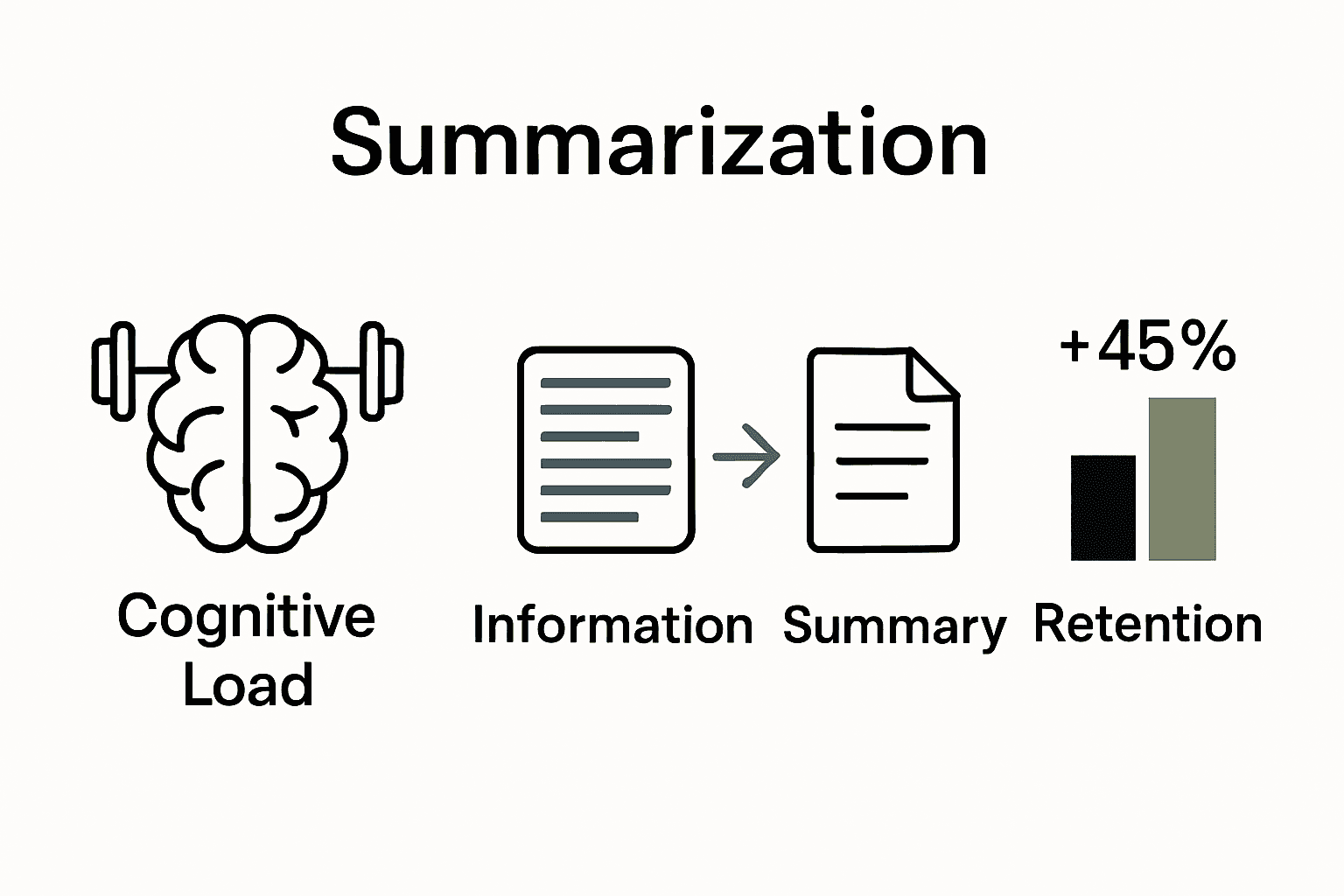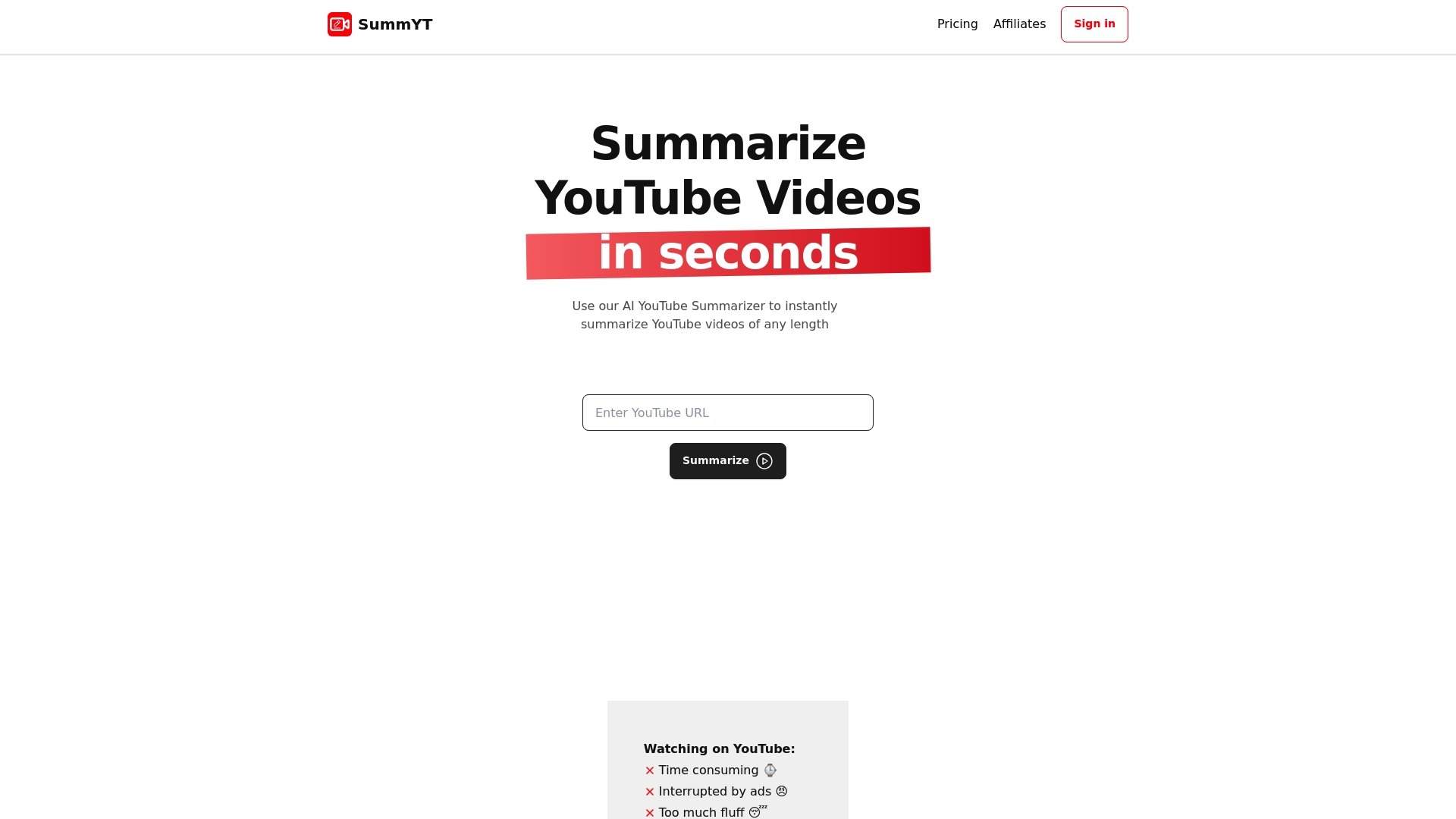Why Summaries Boost Retention: Complete Guide

Did you know that summarizing information can improve memory retention by as much as 45 percent? Many people struggle to absorb complex material, yet the way we condense and organize knowledge makes a dramatic difference. By turning piles of information into clear, focused summaries, you can sharpen your understanding, reduce overwhelm, and make learning stick longer and faster.
Key Takeaways
| Point | Details |
|---|---|
| Cognitive Function of Summaries | Summaries help reduce cognitive load, enhancing memory retention by transforming complex information into digestible insights. |
| Diverse Summary Types | Various summary types cater to specific needs, including abstracts, executive summaries, and analytical summaries, each serving distinct communication purposes. |
| Enhancing Learning Processes | Summarization practices, such as retrieval practice and spaced learning, significantly improve comprehension and information storage. |
| Common Mistakes | Key pitfalls in summary creation include verbosity, personal bias, and lack of structure, which can hinder effective knowledge retention. |
Table of Contents
- Defining Summaries And Cognitive Retention
- Types Of Summaries And Their Uses
- How Summaries Enhance Learning Processes
- Summaries In Modern Learning Environments
- Common Mistakes When Using Summaries
Defining Summaries And Cognitive Retention
A summary is a strategic cognitive tool that transforms complex information into concise, digestible insights. According to research from cognitive learning studies, summaries serve as essential cognitive filters that condense intricate concepts into manageable chunks, directly supporting our brain’s memory processing mechanisms.
At its core, cognitive retention involves how effectively our brain stores, encodes, and later retrieves information. Understanding how summaries aid learning reveals that summaries minimize working memory strain by presenting information in streamlined formats. This reduction in cognitive load enables faster pattern recognition and supports more efficient encoding of knowledge into long-term memory.
The cognitive benefits of summaries are multifaceted. They help learners:
- Rapidly identify key concepts
- Reduce information overwhelm
- Create mental shortcuts for complex ideas
- Enhance comprehension by focusing on core insights
Research indicates that well-crafted summaries act as powerful memory bridges, helping individuals transition from surface-level understanding to deeper, more integrated knowledge. By breaking down complex information into clear, structured narratives, summaries transform passive consumption into active learning, making knowledge retention not just possible, but significantly more probable.
Types Of Summaries And Their Uses
Summaries are not one-size-fits-all tools. Different contexts require specific summary approaches tailored to audience needs and communication objectives. 7 Types of Content Summaries You Need to Know highlights the diverse landscape of summary techniques used across professional and academic domains.
In academic settings, several distinct summary types emerge. Abstracts provide concise overviews of research papers, capturing purpose, methods, results, and conclusions in a compact format. Executive summaries target decision-makers, presenting key findings and recommendations for strategic planning. Critical summaries go beyond simple reporting, evaluating the strengths and weaknesses of a text to offer nuanced insights.
Beyond academic contexts, summary types include:
- Informative summaries: Comprehensive breakdowns of complex topics
- Indicative summaries: Brief outlines suggesting content without detailed explanation
- Descriptive summaries: Offering a surface-level overview of key points
- Analytical summaries: Deep-dive evaluations examining underlying arguments and implications
The goal of any summary is transforming dense information into accessible, digestible knowledge. By understanding and applying the right summary approach, learners and professionals can dramatically improve information retention, comprehension, and communication efficiency.

Here’s a comparison of common summary types and their primary uses:
| Summary Type | Main Purpose | Typical Use Cases |
|---|---|---|
| Abstract | Summarize research highlights | Academic papers, journals |
| Executive Summary | Present key findings, recommendations | Business reports, proposals |
| Critical Summary | Evaluate strengths & weaknesses | Reviews, academic critiques |
| Informative Summary | Offer detailed breakdown | Textbooks, instructional guides |
| Indicative Summary | Outline main topics only | Catalogs, reference materials |
| Descriptive Summary | Provide surface-level overview | News articles, event briefs |
| Analytical Summary | Deep-dive evaluation | Research analysis, policy reviews |
How Summaries Enhance Learning Processes
Summaries are powerful cognitive tools that transform passive learning into active engagement. Understanding How Summaries Aid Learning Effectively reveals the intricate ways these concise knowledge packages support our brain’s learning mechanisms, turning complex information into digestible insights.
Research demonstrates remarkable benefits of summarization. According to studies, writing summaries immediately after learning can improve retention by approximately 45%. This significant boost occurs because summarizing in one’s own words helps consolidate memory, forcing learners to process and restructure information actively. By distilling key concepts, summaries create mental shortcuts that facilitate faster comprehension and more efficient information storage.
The learning enhancement process through summaries involves several key strategies:
- Retrieval practice: Summaries prompt active recall of learned material
- Spaced learning: Concise review materials support repeated engagement
- Cognitive consolidation: Breaking down complex ideas into manageable chunks
- Mental mapping: Creating connections between different pieces of information
Ultimately, summaries act as cognitive bridges, transforming dense educational content into clear, memorable knowledge. They reduce cognitive load, enhance comprehension, and provide learners with strategic tools to navigate and retain complex information more effectively.

Summaries In Modern Learning Environments
Modern learning environments are experiencing a transformative shift, with digital technologies fundamentally reshaping how we process and retain information. Understanding the Role of Concise Summaries in Education highlights how emerging technologies are integrating intelligent summarization strategies to personalize and optimize learning experiences.
Emerging technologies like AI-powered platforms are revolutionizing information management by tailoring content delivery. These advanced systems use summaries as strategic tools to transform large data volumes into actionable insights, enabling more efficient knowledge transfer across professional and academic domains. By adapting review schedules and content complexity to individual learning patterns, these technologies make learning more accessible and engaging.
Key characteristics of summaries in modern learning environments include:
- Adaptive learning paths: Personalized content progression
- Cross-platform accessibility: Seamless information transfer
- Interdisciplinary communication: Breaking down complex knowledge barriers
- Real-time knowledge synthesis: Rapid information processing
Ultimately, summaries have evolved from simple note-taking tools to sophisticated knowledge management systems. They now serve as critical interfaces between raw information and meaningful understanding, bridging gaps in learning across diverse technological platforms and learning contexts.
Common Mistakes When Using Summaries
Creating effective summaries is an art that requires precision and strategic thinking. 7 Types of Content Summaries You Need to Know reveals that many learners unknowingly sabotage their own learning by making fundamental errors in summary creation and usage.
Research highlights several critical mistakes that can undermine the effectiveness of summaries. One significant pitfall is including personal opinions or irrelevant details that distract from core content. Academic writing emphasizes objectivity and clarity, warning that seductive but tangential information can impose extraneous cognitive load, ultimately impairing knowledge retention and comprehension.
The most common summary mistakes include:
- Lack of conciseness: Overly verbose summaries that lose the core message
- Inserting personal bias: Contaminating objective information with subjective interpretations
- Neglecting core ideas: Focusing on peripheral details instead of key concepts
- Failing to structure content: Presenting information without logical progression
Mastering summary creation requires discipline and practice. By avoiding these common traps and focusing on clear, objective, and structured information synthesis, learners can transform summaries from potential knowledge barriers into powerful learning tools that enhance understanding and retention.
Transform How You Retain Video Knowledge with SummYT
Struggling to keep up with endless lectures, tutorials, and webinars? If overloaded information and long videos are making learning feel overwhelming, you are not alone. The article explained how summaries reduce cognitive load, highlight key concepts, and help you retain more. Now imagine applying those same cognitive retention strategies to every YouTube video you watch—instantly.

SummYT lets you skip the fluff and get clear, concise summaries of any educational video, unlocking all the cognitive benefits discussed in Why Summaries Boost Retention: Complete Guide. With unlimited AI-powered summaries and multilingual support, you can convert any video into memorable insights within minutes. Make your YouTube learning smarter and more productive today. Visit SummYT now to start transforming your study habits or work research. Join the movement of learners using summaries to gain an edge—get the essential takeaways from every video now.
Frequently Asked Questions
How do summaries improve cognitive retention?
Summaries enhance cognitive retention by condensing complex information into digestible insights, reducing cognitive load and making it easier for our brains to store and retrieve information.
What types of summaries are most effective for learning?
Effective types of summaries for learning include abstracts, executive summaries, informative summaries, and analytical summaries, each serving specific purposes depending on the context and audience.
What common mistakes should I avoid when creating summaries?
Common mistakes to avoid when creating summaries include lack of conciseness, inserting personal bias, neglecting core ideas, and failing to structure the content logically.
How can I utilize summaries in modern learning environments?
In modern learning environments, summaries can be used as adaptive learning tools, enabling personalized content progression, real-time knowledge synthesis, and enhanced interdisciplinary communication.
Recommended
- Understanding Why Use Video Summaries for Effective Learning
- 7 Effective Ways to Summarize Lectures for Better Retention
- Understanding How Summaries Aid Learning Effectively
- Understanding the Role of Summaries in Research
- How to Create Captivating Content: Proven 2025 Tips for SMBs
- How to Write an Effective Summary of Research Paper



